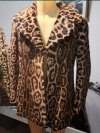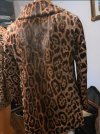Just chiming back in here to offer a little more information that may help you understand how I am able to ascertain that it is genuine from the photos.

The thickness of pony skin, (really calfskin or cow), is greater than that of fabric. It’s not as pliable or flexible as fabric, and over time the skin ages and the pliability lessens, which is why you see curve in areas as it’s hanging like within the sleeves. You can also feel the difference in pliability too.
You can’t always tell the difference visually or by the pliability and in those cases you can always do a burn test. If real hair/fur smells like hair and burns fast. If faux it melts and smells like plastic.
If it will assure you more you can snip a little hair/fur from an inconspicuous area and do a burn test. You really don’t need to though.
Sometimes fur jackets and coats have open French hems that allow you to see the skin side between the lining and the back. More-so coats than jackets and other types of furs.
There are other identifiers too. If you need more assurance and/or information we’re happy to assist.



 I bet you could write a great book yourself. I do not have any plans to write a book, ever, however, with the amount of words I use, it is sort of like a book almost every time I post.
I bet you could write a great book yourself. I do not have any plans to write a book, ever, however, with the amount of words I use, it is sort of like a book almost every time I post. 